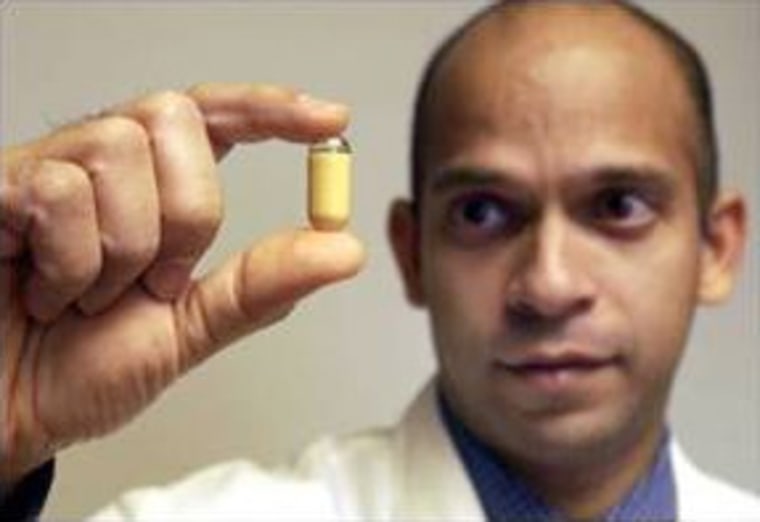Doctors have used small cameras on snaking tubes for years to check patients’ intestinal troubles. These days, they’re asking some patients to swallow the entire camera.
With a single pill loaded with technology similar to a digital camera, doctors can view more than 50,000 still images captured during the trip through the final 20 feet of the small intestine that previously was visible only on X-rays.
The pill, known as the M2A Capsule Endoscopy, is about the size of a multivitamin and is swallowed with a sip of water.
The camera, encased in a white plastic capsule, takes pictures which are transmitted on a radio frequency. The images are captured in a recording device worn on a belt around the patient’s waist. After eight hours, the belt is turned over to the doctor.
The device is a “marvel of microelectronics,” said Dr. David Ramkumar, a gastroenterologist at the University of Iowa Hospitals and Clinics, where patients since the beginning of the year have been swallowing the capsules to diagnose intestinal problems.
Hospitals and clinics around the country, in increasing numbers, have been using the technology since the Food and Drug Administration approved it in December 2001.
Seventy-one-year-old Ruth Brown wanted to know why she was suffering from persistent intestinal bleeding. Her doctors had probed her stomach and performed a colonoscopy, but were stumped.
They suggested the camera pill.
“I looked at it and said, ’Oh, doctor, I can’t swallow that,”’ Brown said. “A great big horse pill — that’s what it looked like.”
Despite her worries, she swallowed it with a mouthful of ice water.
Patients fast for 10 hours before taking the pill, and are able to go about their days as long as they avoid strenuous activity. Brown was able to work her regular volunteer shift at a hospital.
Doctors finally see the end
For years, doctors used cameras on elongated flexible tubes to examine the upper portions of the digestive system and the colon. About 20 feet of the small intestine could not be reached with the endoscope so doctors would have patients swallow barium, then X-ray the area to look for trouble spots — a test Ramkumar called unreliable.
Invasive surgery would be the next option if a disorder was diagnosed.
The tiny camera “provides a view of that middle portion of the digestive tract that we have not had previously,” Ramkumar said.
The camera pill has been an effective way to diagnose unexplained bleeding, Crohn’s disease, celiac disease and intestinal tumors. Ramkumar said the pill has been successful on patients who, like Brown, show clear evidence of intestinal bleeding, but in whose cases conventional tests have not turned up a cause.
Using the images retrieved by the camera, Ramkumar determined that Brown’s persisent bleeding was caused by radiation burns in her small intestine left over from cancer treatment seven years earlier, and exacerbated by a prescription blood thinner.
“They’ve taken me off the blood thinner,” Brown said, and since then her bleeding has been much less. Brown said the burns are so spotty that doctors decided it would be impossible to cut them all out, but the steps taken since the diagnosis have improved her health immeasurably.
Doctors at the University of Iowa Hospitals and Clinics expect to treat more than 150 patients with the camera pill by the end of the year, spokesman Tom Moore said.
The procedure costs about $1,200 at the hospital in Iowa City. Ramkumar said the pills are purchased directly from the manufacturer, Israel-based Given Imaging, for $450 each, a price included in the cost of the procedure.
At the University of Iowa Hospitals and Clinics, results so far have shown a 60 percent to 70 percent success rate in detecting abnormalities. That may seem low, but it is considerably better than old methods of detection, Ramkumar said.
The pill isn’t 100 percent successful because, due to its small size, the camera can capture an image of only about 70 percent of the digestive tract at any one point, he said.
Still, “If you compare that with what we had before, we were looking at rates optimistically in the 30 to 40 percent range,” Ramkumar said. “We’re practically doubling our success.”
Once the images are recorded and the camera belt is removed, the patient simply passes the pill.
“They aren’t used again,” Moore said.
